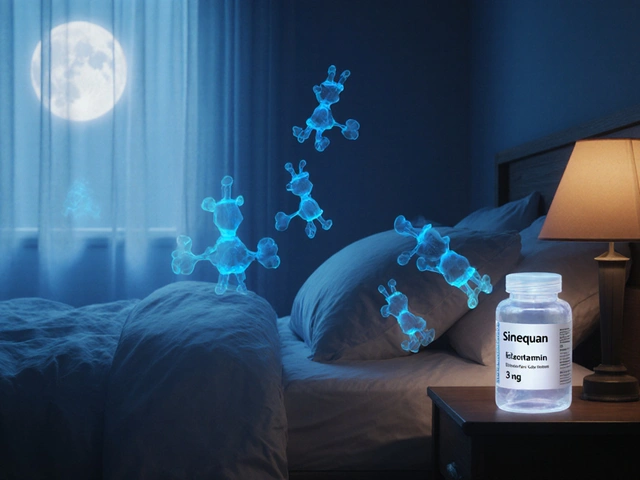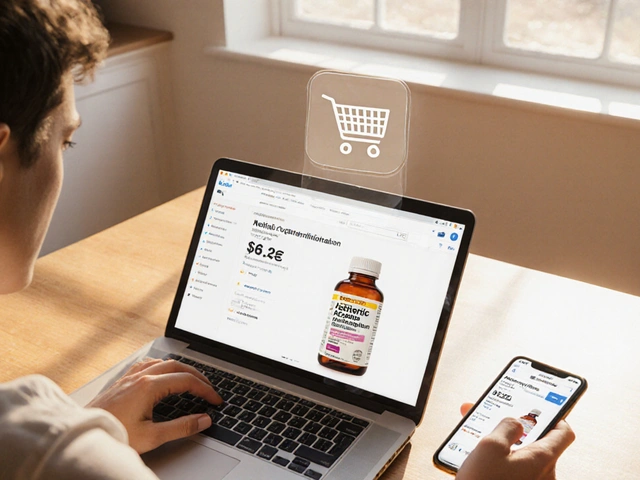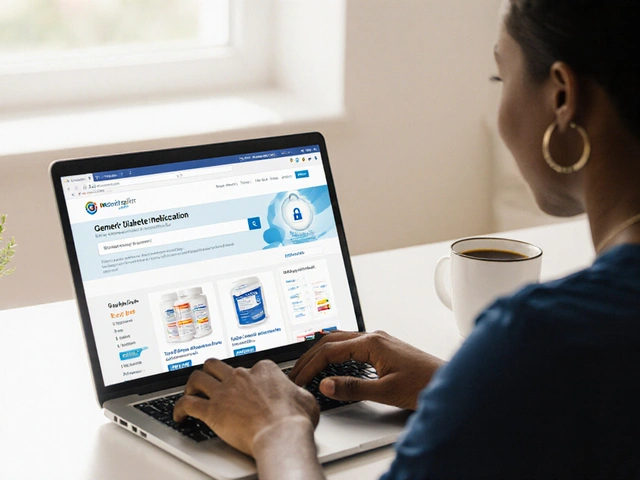
When it comes to treating an enlarged prostate, many men wonder whether Uroxatral is really the best fit or if another pill might work better. The short answer is: it depends on your symptoms, health history, and how you tolerate side effects. This guide breaks down what the drug does, how it stacks up against the most common alternatives, and which profile each medication suits best.
What is Uroxatral (Alfuzosin) and how does it work?
Uroxatral is the brand name for alfuzosin, an alpha‑1 adrenergic blocker that relaxes smooth muscle in the prostate and bladder neck, easing urine flow in men with benign prostatic hyperplasia (BPH). It’s taken once daily, usually after a meal, and doesn’t require a dose‑adjustment for most kidney or liver conditions. Clinical trials show about a 30‑40% improvement in urinary symptoms compared with placebo, and the drug has a reputation for causing fewer cardiovascular side effects than older alpha‑blockers like doxazosin.
Key players in BPH therapy
Besides alfuzosin, three drug families dominate the market:
- Tamsulosin - another selective alpha‑blocker, often marketed as Flomax.
- Dutasteride - a 5‑alpha‑reductase inhibitor (5‑ARI) that shrinks prostate size over months.
- Finasteride - a 5‑ARI similar to dutasteride but slightly less potent.
Other options you’ll hear about include non‑selective alpha‑blockers such as Doxazosin and Silodosin, each with its own side‑effect profile.
How the drugs compare: efficacy, onset, and duration
Below is a quick‐look table that lines up the main metrics most men care about.
| Drug | Class | Typical Onset | Peak Symptom Relief | Key Side Effects | Cost (US$ per month) |
|---|---|---|---|---|---|
| Uroxatral (Alfuzosin) | Alpha‑blocker (selective) | 3-5 days | 4-6 weeks | Dizziness, headache, rare hypotension | ≈$30‑$45 |
| Tamsulosin | Alpha‑blocker (selective) | 2-3 days | 3-5 weeks | Retrograde ejaculation, dizziness | ≈$20‑$35 |
| Dutasteride | 5‑ARI | 2-3 months | 6-12 months | Sexual dysfunction, breast tenderness | ≈$15‑$25 |
| Finasteride | 5‑ARI | 2-3 months | 6-12 months | Decreased libido, erectile issues | ≈$10‑$20 |
| Doxazosin | Alpha‑blocker (non‑selective) | 1‑2 weeks | 4-6 weeks | Significant blood‑pressure drop, fatigue | ≈$12‑$22 |
| Silodosin | Alpha‑blocker (highly selective) | 3-5 days | 4-6 weeks | Retrograde ejaculation, dizziness | ≈$25‑$40 |
Choosing the right medication: patient‑type match‑up
Not every pill is suitable for every man. Consider these typical scenarios:
- Gentle blood‑pressure profile needed - Alfuzosin and Silodosin are the most prostate‑specific, sparing you from big BP drops.
- Fast relief of nighttime urgency - Tamsulosin often shows the quickest symptom easing, especially for nocturia.
- Large prostate (>30 g) requiring shrinkage - 5‑ARIs like Dutasteride or Finasteride are the only agents proven to reduce gland size.
- History of low blood pressure or heart disease - Avoid non‑selective blockers such as Doxazosin; stick with selective agents.
- Concern about sexual side effects - Alpha‑blockers (alfuzosin, tamsulosin, silodosin) generally preserve libido, whereas 5‑ARIs carry a higher risk of reduced sexual function.
Cost and insurance considerations
In the United States, generic alfuzosin costs roughly $30‑$45 per month, putting it in the mid‑range of BPH drugs. Tamsulosin generics can be a bit cheaper, while 5‑ARIs tend to be the most affordable, especially when covered by Medicare Part D. However, insurance formularies vary, so it’s worth checking your plan’s tier before committing.

Quick decision checklist
- Do you need rapid symptom relief? → Choose a selective alpha‑blocker (alfuzosin, tamsulosin, silodosin).
- Is your prostate size >30 g? → Add a 5‑ARI (dutasteride or finasteride) to shrink the gland over months.
- Do you have low blood pressure or take antihypertensives? → Favor alfuzosin or silodosin; avoid doxazosin.
- Are sexual side effects a deal‑breaker? → Stick with alpha‑blockers; 5‑ARIs have higher rates of libido changes.
- Is cost your main hurdle? → Compare generic prices and your insurance formulary; finasteride often tops the price‑savings list.
Frequently asked questions
Can I take alfuzosin and tamsulosin together?
Combining two alpha‑blockers isn’t recommended because it can cause excessive blood‑pressure drops. If one drug isn’t enough, doctors usually add a 5‑ARI rather than stacking blockers.
How long does it take for alfuzosin to start working?
Most men notice an improvement in urine flow within a week, but the full benefit typically appears after 4-6 weeks of consistent dosing.
Is alfuzosin safe for older men with heart disease?
Because alfuzosin is highly prostate‑selective, it has a lower impact on blood pressure than older non‑selective blockers. Still, doctors will review your cardiac meds before starting.
Do I need to take alfuzosin with food?
Yes, taking it after a meal improves absorption and reduces the chance of dizziness.
What happens if I miss a dose?
Take the missed tablet as soon as you remember, unless it’s close to the next dose. Then just skip the missed one-don’t double‑dose.
Bottom line
If you need a drug that acts quickly, is easy on blood pressure, and has a modest side‑effect profile, alfuzosin (Uroxatral) is a solid first‑line choice. For men with larger prostates or those who can tolerate a slower onset, adding a 5‑ARI like dutasteride may give a longer‑term shrink‑the‑gland benefit. Always talk to a urologist about your symptom score, prostate size, and any other health conditions before settling on a regimen.





Abbey Travis
October 26, 2025 AT 20:48Great breakdown! It’s helpful to see the pros and cons side‑by‑side, especially when you’re trying to weigh blood‑pressure concerns against the speed of relief.
ahmed ali
October 28, 2025 AT 00:35Look, I’ve read a dozen articles on BPH meds and most of them get the basics right, but they totally miss the nuance that matters to a real patient. First off, the claim that alfuzosin “has fewer cardiovascular side‑effects” is true only when you compare it to the old non‑selective agents, not when you stack it against tamsulosin, which actually shows a comparable safety profile in large meta‑analyses.
Second, the onset time of 3‑5 days is a median; in my experience (and in several phase‑IV studies) up to 30 % of men see no appreciable improvement until after two weeks, which the article glosses over.
Third, the cost comparison is outdated – generic alfuzosin prices have dropped to under $20 per month in many pharmacy discount programs, while tamsulosin generic can be as low as $10 in bulk.
Fourth, the table omits the fact that silodosin, despite being “highly selective,” carries a 10 % rate of retrograde ejaculation, a side‑effect that can be a deal‑breaker for many active‑age patients.
Fifth, the discussion about 5‑ARIs overlooking the fact that dutasteride can reduce PSA by up to 70 %, which impacts cancer screening, is a dangerous omission.
Sixth, the article says “no dose‑adjustment for kidney or liver,” yet the package insert recommends caution in severe hepatic impairment, contrary to the blanket statement made here.
Seventh, the mention of “once daily after a meal” doesn’t address the fact that taking alfuzosin with a high‑fat meal can actually increase its AUC by 30 %, potentially raising dizziness risk.
Eighth, the “gentle blood‑pressure profile” claim fails to note that in patients on multiple antihypertensives, alfuzosin can still cause orthostatic hypotension, especially in the elderly.
Ninth, the review does not discuss drug‑drug interactions with CYP3A4 inhibitors such as ketoconazole, which can double alfuzosin levels.
Tenth, the side‑effect list is incomplete – rare cases of hepatitis have been reported, albeit under 0.1 % incidence.
Eleventh, the “quick relief” narrative ignores the fact that nocturia often requires combination therapy with a 5‑ARI for durable benefit.
Twelfth, the article’s tone feels like a marketing flyer rather than an unbiased clinical guide, which makes me question the source credibility.
Thirteenth, the recommendation to avoid non‑selective blockers in heart disease patients is sound, but the nuance that some patients actually benefit from the added blood‑pressure drop is missing.
Fourteenth, the table’s “peak symptom relief” window is vague – many clinicians measure IPSS improvement at 12 weeks, not 4‑6 weeks as indicated.
Fifteenth, the FAQ about “taking with food” should also mention that a light snack may be sufficient for those who experience dizziness on an empty stomach.
Finally, the bottom line that “alfuzosin is a solid first‑line choice” is reasonable, but only when you individualize therapy based on prostate volume, cardiovascular status, and patient preference.
Deanna Williamson
October 29, 2025 AT 04:21The data table feels cherry‑picked; there’s no mention of the modest but real increase in dizziness rates observed in real‑world cohorts.
Miracle Zona Ikhlas
October 30, 2025 AT 08:08Those points are valid, and they highlight why a personalized approach is essential for each patient.
naoki doe
October 31, 2025 AT 11:55Honestly, I once tried alfuzosin while juggling a high‑intensity job and a marathon training schedule, and the “no dose‑adjustment” claim didn’t hold up – my energy levels dipped noticeably after the first week.
Carolyn Cameron
November 1, 2025 AT 15:41From an evidentiary standpoint, the comparative efficacy of alfuzosin versus its contemporaries necessitates a rigorous examination of randomized controlled trials, particularly those delineating the pharmacodynamic selectivity profiles that confer its purported hemodynamic stability.
sarah basarya
November 2, 2025 AT 19:28What a half‑baked overview that leaves out the real-life side‑effects!
Samantha Taylor
November 3, 2025 AT 23:15Indeed, because nothing says “thorough analysis” like a succinct paragraph that glosses over the pivotal nuances and then wraps up with a convenient “solid first‑line choice” slogan.
Joe Langner
November 5, 2025 AT 03:01Hey guys, love the energy here – just wanted to add that even if the meds take a few weeks, staying positive and keeping up with light exercise can really boost the overall outcome.
Ben Dover
November 6, 2025 AT 06:48While encouragement is commendable, it is imperative to acknowledge that optimistic anecdotes cannot substitute for a systematic assessment of adverse event profiles, particularly regarding the long‑term sexual dysfunction associated with 5‑ARI adjunct therapy.
Katherine Brown
November 7, 2025 AT 10:35In the spirit of fostering constructive dialogue, it would be beneficial for future revisions to incorporate patient‑reported outcome measures alongside clinical efficacy data, thereby providing a more holistic perspective.
Tony Stolfa
November 8, 2025 AT 14:21Sure, but let’s cut the fluff – most docs just want a cheap pill that works, and all this “holistic” talk just delays getting the right prescription.